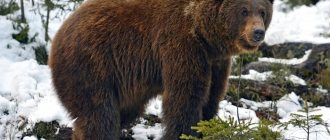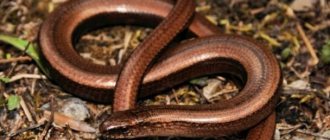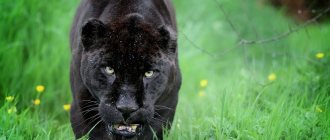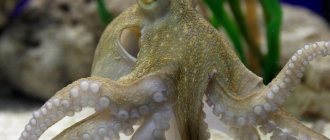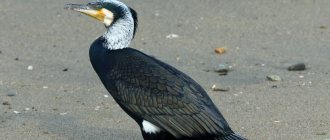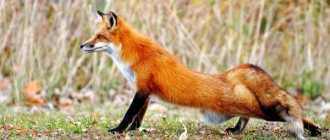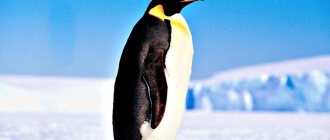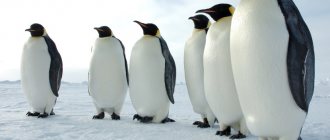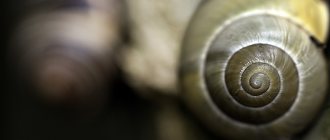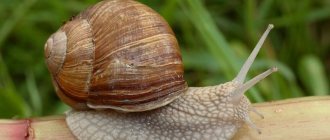- Wild animals
- >>
- Reptiles
The black mamba is the one that can kill. This is exactly how the indigenous Africans perceive it. They experience extreme fear of this reptile, so they don’t even risk saying its name out loud, because according to their belief, the mamba will appear and bring a lot of trouble to those who mention it. Is the black mamba really so scary and dangerous? What is her snake-like disposition like? Maybe all these are medieval horror stories that have no justification? Let's try to find out and sort it out.
Origin of the species and description
Photo: Black Mamba
The black mamba is a formidable venomous reptile from the asp family, belonging to the genus mamba. The genus name in Latin is “Dendroaspis”, which translates as “tree snake”. Albert Gunther, a British herpetologist and German by nationality, was the first to describe the reptile under this scientific name. This happened back in 1864.
Native Africans are indeed very afraid of the black mamba, which they consider powerful and dangerous. They call her “the one who takes revenge for the wrongs caused.” All these terrible and mystical beliefs regarding reptiles are not unfounded. Scientists say that the black mamba is undoubtedly very poisonous and very aggressive.
Video: Black Mamba
The closest relatives of the dangerous reptile are the narrow-headed and green mambas; they are inferior in size to the black one. And the dimensions of the black mamba are impressive; it is in second place among venomous snakes, after the king cobra. The average length of a snake's body is from two and a half to three meters. There are rumors that individuals over four meters in length have been encountered, but this has not been scientifically proven.
Many people incorrectly believe that the mamba was nicknamed black because of the color of its snake skin, but this is not true. The mamba’s skin is not black at all, but its entire mouth from the inside; when the reptile is about to attack or gets angry, it often opens its mouth, which looks quite scary and threatening. People even noticed that the open black mouth of the mamba is similar in shape to a coffin. In addition to the black mucous membrane of the mouth, the mamba has other external features and symptoms.
Antitoxin against snake venom
At the moment, the production of antitoxin is quite expensive. To create it, venom is first squeezed out of a snake (spider or insect), then it is diluted and injected into a horse, sheep or duck
.
Next, the response of the immune system is expected, as a result of which antibodies are produced against the active molecules of the poison. These antibodies are then produced in the animal's blood and are used to combat poisoning.
“When people see what I do, they usually swear or ask if I’m going to die. The photographs prove that I am immune. This is the only way people can believe in this, as well as in the fact that the way to independently develop immunity really works
“, says the American.
“It takes a very high level of mental effort to pull yourself together and allow yourself to be bitten. Injecting yourself with poison is one thing, but allowing yourself to be bitten by a poisonous snake is a completely different matter.
“, he explains.
Appearance and features
Photo: Black mamba snake
The characteristic structure of the mamba's mouth is somewhat reminiscent of a smile, only very dangerous and unkind. We have already figured out the dimensions of the reptile, but its average weight usually does not exceed two kilograms. The reptile is very slender, has an extended tail, and its body is slightly compressed on the upper and lower sides. The color of the mamba, despite its name, is far from black.
The snake can be of the following colors:
- rich olive;
- greenish-olive;
- grey-brown.
- black.
In addition to the general tone, the color scheme contains a characteristic metallic sheen. The snake's belly is beige or off-white. Closer to the tail, spots of a dark shade can be visible, and sometimes light and dark spots alternate, creating the effect of transverse lines on the sides. The color of young animals is much lighter than that of mature individuals; it can be light gray or light olive.
Interesting fact: Although the black mamba is smaller in size than the king cobra, it has poisonous fangs of much greater length, reaching more than two centimeters, which are mobile and fold when necessary.
The black mamba has several titles at once; it can safely be called:
- the most poisonous reptile on the African continent;
- owner of the fastest-acting poisonous toxin;
- the longest slate snake on African territory;
- the fastest reptile on the entire planet.
It’s not for nothing that many Africans are afraid of the black mamba; it really does look very aggressive and ominous, and its considerable dimensions will stupefy anyone.
The extraordinary smile of a reptile
All those who have ever seen a Black Mamba live talk about the unusual sweet smile reflected on the snake’s mouth. This is due to the special anatomy - the unique cut of her mouth. She leads a terrestrial lifestyle and, only in very rare cases, for example, to take a sunbath, climbs to higher elevations.
The snake loves semi-arid climates. It often reaches three meters in length and can develop enormous speed in pursuit of prey over short distances.
The Black Mamba received its name not because of its body color, which can be light or dark, but because of its black mouth cavity, which it opens when in danger and hisses ominously. It looks like a black coffin. The upper jaw in the front has teeth about 7 millimeters long. Even such short fangs are enough to bite through the skin of the victim and inject deadly poison into it.
Where does the black mamba snake live and how does the most dangerous snake in Africa live?
The black mamba snake lives in Central, Eastern and Southern Africa, preferring semi-arid areas. The black mamba mainly lives in savannas and woodlands. The black mamba snake rarely climbs trees and bushes, mainly leading a terrestrial lifestyle. This dangerous snake of Africa has a large distribution area. The black mamba is found in northeastern Democratic Republic of Congo, South Sudan, southern Ethiopia, Eritrea, Somalia, Kenya, eastern Uganda, Tanzania, Burundi and Rwanda. In southern Africa, the black mamba snake lives in Mozambique, Swaziland, Malawi, Zambia, Zimbabwe, Botswana, Namibia, southern Angola and KwaZulu-Natal. This is the wide range of one of the most dangerous snakes in Africa.
Compared to other mambas, this one is least adapted for life in trees. Therefore, the poisonous black mamba mainly lives on the ground among shrubby vegetation. To bask in the sun, the black mamba snake can climb a tree or bush, but still prefers to be on the ground most of the time. Sometimes the black mamba lives in hollow trees, abandoned termite mounds and empty burrows.
The black mamba also lives on rocky slopes and in river valleys with fallen trees. The black mamba snake prefers to build long-term nests for living. Africa's most dangerous snake does not live in deserts or dense tropical forests. As a rule, the black mamba snake lives no higher than 1 km above sea level. But in Zambia, the black mamba is found at an altitude of 1.5 km above sea level, and in Kenya up to 1.8 km.
Despite the fact that the black mamba is the most dangerous and poisonous snake in Africa, even it has enemies. The main enemies of the black mamba are some birds of prey that hunt it. First of all, these are black and brown snake eaters; the black mamba snake most often becomes their victim. Another enemy of the black mamba is the needle snake, which has an innate immunity to the venoms of all African snakes. Also dangerous for the black mamba are mongooses, which sometimes hunt it and deftly avoid attacks, and also have acquired immunity from the bite of the black mamba.
Spine
Since this reptile does not have developed limbs, there are no specific sections in its spine. It has increased flexibility, uniformity and great length. It is noteworthy that the vertebrae are all absolutely identical and the same identical ribs are attached to them. Their number depends on the size of the snake. It is reliably known that the fastest snake can have up to 430 vertebrae. It has no sternum, like other species of snakes. Thanks to this feature, the snake can curl into rings as much as its length allows.
Who does the black mamba kill?
The black mamba snake has a bad reputation and in Africa local residents shudder when they hear its name. On the continent, the snake is respected, revered and greatly feared. And not in vain, because local residents talk about the black mamba as a symbol of death, even the name of the snake in their language means “black death”. In areas of Africa where this snake is common, there are a lot of myths and legends about the black mamba.
The black mamba is feared because it is very poisonous and fast. The black mamba snake is very mobile and agile; it silently glides along the ground with its head held high. The Guinness Book of World Records lists the black mamba as the fastest snake in the world, as a black mamba's speed of 11 km/h is common. However, there are also unsubstantiated legends about the increase in the speed abilities of this snake.
Despite its far from peaceful nature, the most poisonous snake, the black mamba, still tries to avoid contact when meeting a person. She freezes to remain unnoticed and tries to sneak away unnoticed. In most cases, the black mamba attacks only when it is caught by surprise or cornered. If contact cannot be avoided, the black mamba snake becomes aggressive, but it never hisses. The black mamba rises, leaning on its tail and opens its mouth wide; this pose is of a warning nature. After which the black mamba makes a series of lightning-fast throws and instantly inflicts a bite on the body or face. It happens that a black mamba snake can bite on the move, when trying to hide, but choosing the wrong direction towards the one who disturbed it. In such cases, a person does not immediately discover that he has become a victim of a black mamba bite. But after some time, various symptoms of poisoning appear.
The black mamba snake is very dangerous, the main danger is the poison of the black mamba. The bite of a black mamba is fatal. Fortunately, there is now an antidote. The venom of the black mamba is highly toxic and contains neurotoxins; without an antidote, paralysis and respiratory arrest occur. Death can occur within an hour after the bite, as the black mamba injects a lot of poison.
The black mamba feeds on small animals. The black mamba kills a variety of rodents, bats and birds. The most dangerous snake in Africa hunts during daylight hours, but even at night it can navigate no worse than during the day. Despite its speed abilities, usually the black mamba will attack from an ambush, in which it can wait, hiding for a very long time.
The black mamba snake prefers to ambush in the same place. Body coloring perfectly camouflages it and allows it to remain unnoticed. As soon as the prey comes into view, the black mamba makes a lightning-fast lunge and bites the victim. If one bite is not enough and the animal attempts to escape, it will chase it and inflict new bites until the prey dies from the effects of the poison. The black mamba digests the prey it eats in 8-10 hours.
Black mamba venom contains fast-acting neurotoxins. In one bite, the black mamba injects 100-120 mg of poison, while for an adult the lethal dose is only 10-15 mg. In 100% of cases, without the introduction of an antidote, a person will die.
After a black mamba bite, a person feels a burning pain, and in its place a tumor forms, necrosis is possible. Then digestive system disorders begin (unusual taste in the mouth, abdominal pain, nausea, vomiting, diarrhea). The next stage is the onset of progressive peripheral paralysis and, without the introduction of an antidote, death occurs from respiratory failure. Therefore, if you have been bitten by a black mamba, you should not hesitate to administer the antidote.
Home maintenance
Yes, yes, scary black mambas are bred not only in state zoos: there are eccentrics who keep these snakes in their apartments.
One of the bravest and most experienced terrarium keepers, Arslan Valeev, who systematically posts videos featuring his mambas on YouTube, categorically does not recommend them for home breeding.
According to Valeev, an escaped mamba will immediately rush to find the owner in order to kill him, and you will know about her escape by a lightning bite when entering the room.
The snakekeeper warns that a shift in the asp’s head can happen in one moment, and then the completely tame (as you thought) reptile will pronounce a sentence on you and immediately carry it out.
Arrangement of the terrarium
If these arguments do not convince you, remember what you need to keep black mambas at home.
Firstly, a voluminous terrarium equipped with transparent front doors to observe what is happening inside.
Parameters of a snake housing with a gate valve:
- height not less than 1 meter;
- depth 0.6-0.8 m;
- width is about 2 meters.
Secondly, dense (live or artificial) thickets on snags and branches, which will help snakes adapt to captivity. The branches will also protect overly aggressive or timid individuals from accidental injury.
Thirdly, any loose materials on the bottom: black mambas have a fast metabolism, and newspaper will not suit them.
Reptiles are easily excited by the slightest manipulation in their lair, so you need to clean the terrarium with mambas very quickly and always wear special gloves that can withstand the long snake teeth.
Temperature
In a large terrarium it is not difficult to maintain the desired temperature background - about 26 degrees. The warm corner should heat up to 30 degrees. At night it should not be colder than 24 degrees. It is recommended to use a lamp (as for all land reptiles) of 10% UVB.
Nutrition
Mambas are fed as usual - 3 times a week. This frequency is due to the time of complete digestion, which is 24-36 hours. The diet in captivity is simple: poultry (1-2 times a week) and small rodents.
An overfed mamba will burp, so don't overdo it. And one more reminder: do not feed the snake with tweezers - it moves with lightning speed and does not miss.
Water
Dendroaspis polylepis needs regular spraying. If you are too lazy to do this, put a drinking bowl. Mambas do not drink water very often, using the drinking bowl as a latrine, but water should still be present.
If you don't want to rip off bits of old skin from your reptile's tail, be sure to spray the snake during the molting period.
Reproduction
The mamba reaches sexual maturity at the age of three. Reproduction of Dendroaspis polylepis in captivity is an extraordinary event. So far, only two cases of official breeding of “northern” offspring are known: this happened at the Tropicario Zoo (Helsinki) in the summer of 2010 and in the spring of 2012.
Black mamba breeding season
Since snakes of this species are distributed over a vast territory, in order to create offspring, individuals of different sexes first need to find a partner. The mating season for these snakes begins at the end of May or at the beginning of summer, when the temperature is comfortable for them, and there is a lot of living creatures around that can become food for the hatched young. First, female black mambas, ready to mate, begin to produce pheromones that attract males.
Then the males begin to fight: they exchange strong head blows and twist themselves into knots. At the same time, they do not use their long poisonous fangs, so such battles do not end with serious injuries. During fights, males begin to strangle their opponents in rings. Only the strongest can win.
As a rule, the fight ends when the weaker opponent loosens his grip. After the battle is over, the losing male crawls away. Usually the winner does not pursue his opponent.
Next, the mating process occurs, which takes about 2 hours. Afterwards, the female returns to her lair, where she lays about 12-17 eggs in soft, waterproof shells. Typically, the incubation period lasts from 10 to 40 days, depending on prevailing weather conditions.
The body length of the hatched cubs ranges from 40-60 cm. They are born fully formed and capable of taking care of themselves. From the first days of life, black mamba cubs can swallow rat-sized prey.
Young individuals grow quickly. If they manage to find enough food, by the end of 1 year they reach 2 m in length. In its natural habitat, this snake can live for about 12 years.
Black mamba bite
If you carelessly stand in its path, it will inflict a bite on the move, which may not be noticed at first.
Consider the threatening behavior of the snake (inflating its hood, raising its body and opening its mouth wide) as a gift of fate: in this case, you have a chance to retreat before the fatal throw.
Per bite, a reptile is capable of injecting from 100 to 400 mg of toxin, 10 mg of which (in the absence of serum) is fatal.
But first, the sufferer will go through all the circles of hell with burning pain, swelling of the bite site and local tissue necrosis. Then a strange taste appears in the mouth, abdominal pain, nausea and vomiting, diarrhea, redness of the mucous membranes of the eyes.
The black mamba's venom is oversaturated:
- neurotoxins;
- cardiotoxins;
- dendrotoxins.
Still others are considered the most destructive: they cause paralysis and respiratory arrest. A total loss of control over the body occurs in a short time (from half an hour to several hours).
After a bite, it is necessary to act immediately - the one who is given an antidote and connected to an artificial respiration device has a chance.
But even these patients are not always saved: according to African statistics , 10-15% of those who received the antidote on time die. But if there is no serum at hand, the death of the victim is inevitable.
Where can I buy
It is unlikely that you will find a black mamba seller at a bird market or pet store. Terrarium forums and social networks can help you. To avoid getting into trouble, carefully check the dealer (especially if he lives in another city) - ask your friends and make sure that there is a real snake.
It is better if you take the reptile yourself: in this case, you will be able to examine it for possible illnesses and abandon the sick animal.
It’s worse if a snake worth from 1,000 to 10,000 dollars comes to you by parcel on a train. Anything can happen on the road, including the death of a reptile. But who knows, maybe this is how fate will save you from the deadly kiss of the black mamba.
What does the most poisonous snake eat?
Despite its notoriety as the most dangerous snake in the world, it does not feed on humans or other large mammals. Its diet consists of various small rodents, birds, and mice. She hunts mainly during the day, waiting for prey in a permanent place. The essence of hunting is poisonous bites and pursuit of the victim until he dies from the poison. Digestion takes an average of 9 hours.
The snake's lair, as a rule, is located in trees, under rotten stumps, in old empty termite mounds, in small rocky recesses. Male and female individuals lead separate existences and intersect only for the purpose of mating. This usually occurs in the spring, when females emit special odors that attract competing males. They, in turn, enter into a fight for the most beautiful females and the prize goes to the strongest. The female lays up to twenty eggs, but only about 5 babies survive.
Natural enemies of the black mamba
Photo: Black Mamba
I can’t even believe that such a dangerous and very poisonous creature as the black mamba has enemies in nature who are ready to dine on this rather large reptile. Of course, the black mamba doesn’t have many ill-wishers among animals. These include snake-eagle eagles, primarily black and brown snake-eaters, which hunt the poisonous reptile from the air.
The needle snake is also not averse to feasting on the black mamba, because... There is practically no risk, because she is immune, so the mamba’s venom does not harm her. Fearless mongooses are ardent opponents of black mambas. They have partial immunity to the poisonous toxin, but they cope with the large snake with the help of their dexterity, resourcefulness, agility and remarkable courage. The mongoose harasses the reptile with its fast jumps, which it makes until it seizes the opportunity to bite the back of the mamba’s head, from which it dies. Most often, inexperienced young animals become victims of the above animals.
People can also be considered the enemies of the black mamba. Although Africans are very afraid of these snakes and try never to mess with them, they are gradually displacing them from their places of permanent deployment by building new human settlements. Mamba does not go far from her favorite places; she has to adapt to life next to a person, which leads to unwanted encounters and poisonous fatal bites. The life of black mambas in natural, wild conditions is not easy, and if things go well, they usually live up to ten years of age.
Population and species status
Photo: Poisonous snake black mamba
The black mamba has spread widely throughout various African countries, preferring places where there are tropics. To date, there is no evidence that the population of this poisonous reptile has sharply declined, although there are some negative factors that complicate the life of this snake.
First of all, such a factor includes a person who, while developing new lands, occupies them for his own needs, displacing the black mamba from his habitable places. The reptile is in no hurry to move away from its favorite areas and is forced to live closer and closer to human habitation. Because of this, unwanted meetings between a snake and a person are increasingly occurring, which for the latter can end very tragically. Sometimes a person emerges victorious in such a fight by killing a reptile.
Terrarists interested in black mambas are willing to pay a lot of money in order to have such a pet, so black mambas are caught for the purpose of further sale, because the cost of the reptile reaches tens of thousands of dollars.
Still, we can say that these dangerous reptiles are not under threat of extinction, their numbers do not experience large jumps downward, therefore the black mamba is not listed on special protection lists.
In conclusion, I would like to note that although the black mamba has increased aggressiveness, mobility and swiftness, it will not rush at a person without a reason. People often provoke snakes themselves, invading their places of permanent residence, forcing the reptiles to live next to them and constantly be on guard.
The black mamba , of course, is extremely dangerous, but it attacks only in self-defense, contrary to various mystical beliefs that say that the snake itself comes to take revenge and cause harm.
Belcher
The winner in terms of toxicity is a close relative of the Australian taipan, which is called cruel or ferocious because of its quarrelsome and frantic disposition. A single dose of 400 mg can kill 100 people. The danger of the substance is 10 times greater than the venom of a rattlesnake and 50 times greater than that of a cobra. To our great joy, this creature leads a secretive existence, so no deaths were recorded.
It is reassuring that the individual is peaceful and does not hunt people. There are stories about fishermen who caught her in a net along with fish, or about tourists who decided to hold a beautiful snake in their hands, but even then she did not use her advantage, but made a fictitious bite without using a secret.
The consequences of a poisonous snake attack depend on the area affected, the weight of the person, timely assistance and concomitant diseases. The fact that their toxin is widely used in medicine speaks in favor of reptiles. By taking it away, people are already killing reptiles, because they spend enormous amounts of energy to produce poison.
Danger to humans
The venom of this snake has a pronounced neurotoxic effect. The lethal dose of black mamba venom for humans is only 10–15 mg, despite the fact that in one bite this snake secretes about 400 mg of deadly liquid. If a snake bites a person on the heel or finger, death can occur within 4 hours. If the bite was made closer to the face or neck, then death can occur much faster, in about 20 minutes.
The venom of the black mamba leads to muscle paralysis and at the same time destruction of the nervous system.
Victims of the bite die from suffocation, cardiac arrest and paralysis. If a vaccine is not administered after a bite, the probability of death for a person is close to 100%.
In order to produce an antidote, as well as other medicines, the black mamba is bred in special nurseries. Keeping this snake at home is extremely dangerous.
How should you behave when meeting a Black Mamba?
Tourists traveling to Tanzania should be aware that the country is part of the habitat of this snake.
In particular, the warm jungles of Zanzibar. The black mamba prefers to live in bushes or on isolated trees. Despite the name, it is not completely black. More often, it is a very dark olive-gray color.
But the inner surface of the mouth is really deep black.
Black Mamba. Pay attention to her mouth.
It is worth knowing the basic habits of a snake so as not to become its target:
- Any noise and sudden movements at close range are perceived by the snake as a direct threat. In this case, she will try to attack first;
- Mamba prefers grass or low stones to high branches, on which it basks in the sun. She lives in holes dug at the roots;
- The reptile feeds on small animals and birds, but will bite a large target if it considers it dangerous.
If you see a snake on your way while walking, take safety measures.
First of all, there is no need to move in her direction. It is better to step back very slowly and carefully. Some experts advise making noise and shouting. But this should only be done at a sufficient distance, at least 3 meters.
Then there is a chance that the snake will simply crawl away from you.
Remember that a mamba bite is very dangerous. A person has a little less than an hour left. And if at this time assistance is not provided in the form of an antidote, then death is inevitable.
Unfortunately, it often happened that the antidote simply did not have time to deliver to the victim.
Walk in the jungle
Therefore, it is extremely important that you are accompanied by a qualified guide during your walks in the jungle.
Firstly, he knows exactly what to do when he sees a snake. Secondly, he has an antidote with him that will save you if you are bitten. We provide every tourist with the services of such a guide in Tanzania.
Therefore, you should not risk your own life and go to this exotic country as a “savage”.

